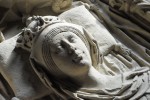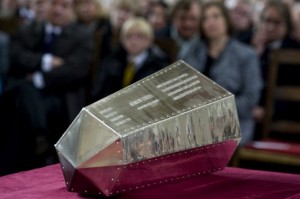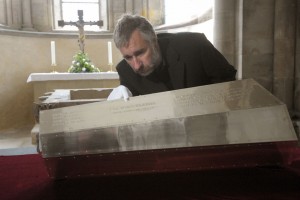 The remains of Queen Eadgyth, granddaughter of Alfred the Great and wife of Holy Roman Emperor Otto I, were reburied in an ecumenical ceremony in Magdeburg Cathedral this Friday. Her bones were found in a lead coffin inside a stone sarcophagus by archaeologists doing some work on the cathedral in 2008. Even though there was a cenotaph dedicated to her in the church, the find was unexpected because her remains were known to have been moved several times.
The remains of Queen Eadgyth, granddaughter of Alfred the Great and wife of Holy Roman Emperor Otto I, were reburied in an ecumenical ceremony in Magdeburg Cathedral this Friday. Her bones were found in a lead coffin inside a stone sarcophagus by archaeologists doing some work on the cathedral in 2008. Even though there was a cenotaph dedicated to her in the church, the find was unexpected because her remains were known to have been moved several times.
The burial wasn’t original. She died in 946 A.D, and an inscription on the lead coffin noted her name and the reburial date (1510), but of course that wasn’t sufficient to prove that the bones belonged to the queen herself. It wasn’t until this year that isotope analysis on her teeth confirmed that the remains did indeed belong to Queen Eadgyth.
Now that the science has been done, the good Queen has been put to her final rest. Again. Hundreds gathered in the 800-year-old Magdeburg Cathedral to pay their respects. First there was an ecumenical 2-hour funerary service with both Lutheran and Catholic clerics presiding, then a closed coffin viewing of Queen Eadgyth’s remains. After that, the coffin was placed inside the stone sarcophagus and reburied under the floor of the cathedral.
The original lead coffin was too corroded and broken to reuse, so the Arts Foundation of Saxony-Anhalt held a competition to chose a new long-lasting coffin design. The winner was Leipzig sculptor Kornelia Thümmel. She created a polygonal container made of titanium that looks like a crystal. On one side of the coffin in a cross, on the other the following inscription: “This sarcophagus contains the mortal remains of Queen Edith, wife of Otto the Great, once again buried Anno Domini 1510, re-discovered by archaeological excavations in 2008 and now again buried in 2010.”


The coffin is so small because there are actually not that many bones left, only 40 out of the usual 200, and some fragments of her skull.
Otto had given the city of Magdeburg to Eadgyth as a wedding present. She was widely beloved and known for her charitable works and kindness. She was never canonized, but she was revered locally as a saint for centuries, hence the missing bones. Whenever she got moved, people helped themselves to pieces of her as relics.